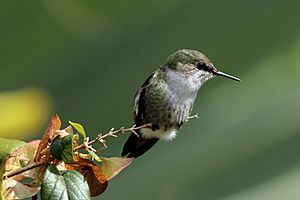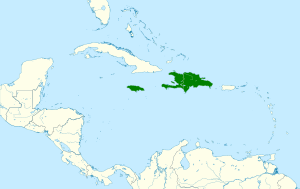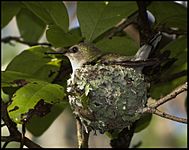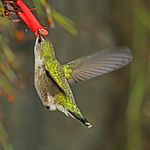Vervain hummingbird facts for kids
Quick facts for kids Vervain hummingbird |
|
|---|---|
 |
|
| In Jamaica | |
| Conservation status | |
| Scientific classification | |
| Genus: |
Mellisuga
|
| Species: |
minima
|
 |
|
| Synonyms | |
|
Trochilus minimus Linnaeus, 1758 |
|
The vervain hummingbird (Mellisuga minima) is a tiny bird. It is a type of hummingbird found in the Caribbean. You can find it on the island of Hispaniola, which is shared by the Dominican Republic and Haiti. It also lives on the island of Jamaica. This hummingbird is known for being one of the smallest birds in the world!
Contents
About the Vervain Hummingbird
What's in a Name?
The vervain hummingbird was first officially described in 1758. A Swedish scientist named Carl Linnaeus gave it the scientific name Trochilus minimus. He wrote about it in his famous book, Systema Naturae. Later, scientists placed it in the genus Mellisuga. This is the same group as the even tinier Cuban bee hummingbird.
There are two main types, or subspecies, of vervain hummingbird:
- M. m. minima (found in Jamaica)
- M. m. vielloti (found on Hispaniola)
How Small Is It?
The vervain hummingbird is one of the smallest birds on Earth. It is usually about 6 centimeters (2.4 inches) long. This includes its bill, which is about 1 centimeter (0.4 inches) long. It weighs only about 2 to 2.4 grams (0.07 to 0.08 ounces). That's less than a penny!
What Does It Look Like?
Male and female vervain hummingbirds look quite similar. However, their tails are a bit different. Both have a short, straight, dull black bill.
- Males: Their upper bodies are a dull metallic green. This color looks almost black on their lower back and tail feathers. Their chin, throat, and chest are light gray with darker spots. Their belly and under-tail feathers are dark metallic green. The male's tail is completely black and slightly forked, like a small "V" shape. Unlike most hummingbirds, males do not have shiny, iridescent feathers.
- Females: They are dark metallic green to bluish-green on their upper bodies and sides. Their throat is light gray, which gets darker towards their belly. The female's tail is rounded, not forked. The middle tail feathers are dark green at the base and black for the rest of their length. The other tail feathers are black with white tips.
Where They Live and What They Do
Where Do They Live?
The M. m. minima subspecies lives only on Jamaica. The M. m. vielloti subspecies lives on the island of Hispaniola. This includes both the Dominican Republic and Haiti. They have also been seen on smaller islands nearby. There has even been one sighting in Puerto Rico.
These hummingbirds can live in many different places. They are found almost everywhere in their range, except inside very thick mountain forests. You can see them in:
- Forests along rivers
- Dry forests
- Desert areas with shrubs
- Gardens
- Even in cities!
They live from sea level up to at least 1,600 meters (5,200 feet) high.
How Do They Move?
Vervain hummingbirds do not fly long distances like some birds that migrate. However, they might move to different elevations. This means they fly higher or lower in the mountains. They do this to find food when it is more available in certain areas.
What Do They Eat?
The vervain hummingbird eats nectar from many different kinds of flowers. They often choose small flowers that don't have a lot of nectar. They do not try to protect their feeding spots from other birds. When they drink nectar, they often hold their tail up.
Besides nectar, they also catch small insects. They do this by flying out from a perch to catch insects in the air. They can also hover in one spot to grab flying insects.
Reproduction and Life Cycle
Male vervain hummingbirds perform special flights to attract females. They fly in flat, horizontal circles. Sometimes they dive between two circles. The breeding season for these birds is from December to August.
The female builds a tiny, cup-shaped nest. She uses soft materials like hair and plant fluff. She covers the outside with lichen or moss. Spiderwebs help hold the nest together and attach it to a branch. Nests are usually hidden and often less than 1 meter (3 feet) off the ground.
A female usually lays two eggs. These eggs are among the smallest of all bird eggs! They are about 1 centimeter (0.4 inches) long and weigh around 0.38 grams (0.013 ounces). The female sits on the eggs for 16 to 19 days. The young birds leave the nest about 21 to 25 days after hatching.
How Do They Communicate?
Male vervain hummingbirds sing a lot! They sing for most of the day from high spots in their territory. They also sing during their courtship flights and when they meet other males. Their song is complex, with many different sounds. Some sounds might be repeated. The songs of the two subspecies are a little different.
Both male and female birds make a "dry 'chittering' scolding sound." They use this sound when they are fighting or having a disagreement with another bird.
Conservation Status
The IUCN (International Union for Conservation of Nature) has listed the vervain hummingbird as a species of "Least Concern." This means they are not currently in danger of disappearing. They live in a large area, and even though we don't know their exact numbers, their population seems stable. They are widespread and can live in many different places, including areas changed by humans. No specific threats have been found for this amazing little bird.
Gallery
See also
 In Spanish: Colibrí zumbadorcito para niños
In Spanish: Colibrí zumbadorcito para niños





